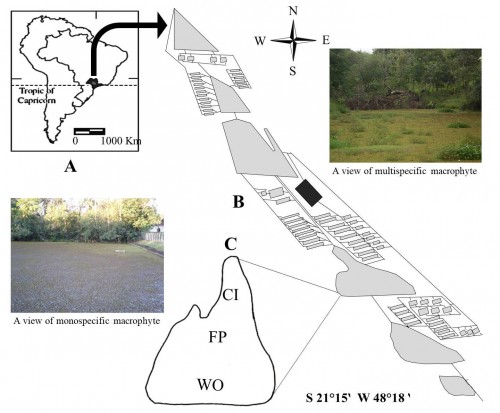Tropical Plant Research
An International Journal by Society for Tropical Plant Research
2017, VOLUME 4 ISSUE 3Pages: 471-479
Macrophyte - environment relationships during a monospecific and a multispecific massive invasion in a fishpond
Lúcia H. Sipaúba-Tavares*, Cecilia B. Anatriello, Ana Milstein, Rodrigo N. Millan & Bruno Scardoeli-Truzzi
*Aquaculture Center, Univ. Estadual Paulista - UNESP, Jaboticabal, São Paulo, Brazil
Abstract:
The current study evaluated the water quality and zooplankton community in a shallow fish pond during two different macrophyte invasions, one of Salvinia auriculata only and the other of several aquatic plants. The results showed that the macrophyte covering of the pond surface led to anoxic conditions, not desirable in fish culture ponds. This negative effect occurred in winter and in summer, and under monospecific and multispecific macrophyte mass developments. The multispecific macrophyte invasion provided a more complex habitat structure that allowed higher zooplankton diversity and species richness but lower zooplankton density than the monospecific invasion. High organic loading may influence the mass development of floating macrophytes in one pond or another. To prevent macrophyte invasions it would be advisable to reduce organic loading in the pond system, which is a fish farm is rather difficult. But if a macrophyte invasion event occurs, proper management practices of plant removal can be applied to solve the immediate problem and to avoid sporocarps dissemination that could launch future such events. The management practices in the fish farm must be adequate to keep good water quality for the production of good market products.
The current study evaluated the water quality and zooplankton community in a shallow fish pond during two different macrophyte invasions, one of Salvinia auriculata only and the other of several aquatic plants. The results showed that the macrophyte covering of the pond surface led to anoxic conditions, not desirable in fish culture ponds. This negative effect occurred in winter and in summer, and under monospecific and multispecific macrophyte mass developments. The multispecific macrophyte invasion provided a more complex habitat structure that allowed higher zooplankton diversity and species richness but lower zooplankton density than the monospecific invasion. High organic loading may influence the mass development of floating macrophytes in one pond or another. To prevent macrophyte invasions it would be advisable to reduce organic loading in the pond system, which is a fish farm is rather difficult. But if a macrophyte invasion event occurs, proper management practices of plant removal can be applied to solve the immediate problem and to avoid sporocarps dissemination that could launch future such events. The management practices in the fish farm must be adequate to keep good water quality for the production of good market products.

Fig.: Diagram of the fish pond studied. Inset A: shaded area indicates southeastern Brazil (the state of São Paulo). Inset B: aquaculture farm of the Univ. Estadual Paulista. Inset C: fishpond studied with sampling sites (CI, FP, and WO) and _-_- = frog culture sector.
| 0 | 1 | 2 | 5 | 8 | 3 | 5 | 1 |


